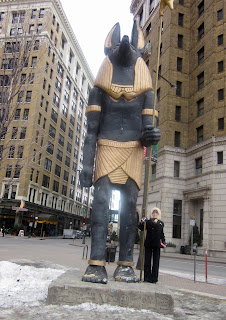On Saturday I spent a while meandering through dimly lit rooms viewing ancient Egyptian artifacts at the Science Museum of Minnesota's latest exhibit, Tutankhamun: The Golden King and the Great Pharaohs. There were brighter lights dotting each room in order to highlight the artifacts, one of which was an honest-to-goodness ancient toilet seat. I gazed at it for a moment, seeing similarities in shape to our modern version and thought, "Yes. Yes, I suppose that would work just fine."
Suddenly I was picturing scantily clad Egyptians trying to maneuver going to the bathroom wearing their heavy gold accessories. Why wasn't there an ancient toilet paper holder? Didn't they have to wipe? Maybe they WERE aliens! My mom sometimes comes to the conclusion that they were aliens, but aliens wouldn't think a giant scarab beetle pushed the sun up from the underworld every day now would would they? I don't know about you, but I've never exactly pictured people of an advanced ancient culture having to take time out of their day to go potty. But here I was, staring at the actual device they used. Don't you love museums?
Tutankhamun is filled with amazing artifacts -- 100 to be exact -- found in Howard Carter's 1922 excavation of King Tut's tomb. There are masterful sculptures that I envisioned flappers looking at for fashion ideas, finely crafted beaded and gold jewelry, and even the boy king's smallish white bed and throne. There's something about staring at an object while knowing it is THE object Tut used that is just so exciting. Kind of like when I saw the actual B3 organ used in the song Green Onions when I went to the Stacks museum in Memphis.
There were many pieces on display that caused me to shake my head, or drop my jaw, or otherwise spasm in wonder. Including one piece that has never traveled outside of Egypt until now. Think of that! Or the little coffinette in which Tut's stomach was enclosed. Of course the bejeweled coffinete is now empty and so is on display slightly opened. I recall there being a drippy smudge inside of it and can't help but think it's some sort of result of the acid in Tutankhamun's stomach.
And then there's the exact replica of Tut's mummified remains, printed from a 3D printer based on actual CAT scan measurements of the body. In some ways I think that is even more impressive than the actual remains of Tut.
There are mysteries surrounding Tut's death and the exhibit does a nice job of presenting what those mysteries are along with the realities of what could have been the cause. There are conjectures as to his death being the result of malaria, or a bone disease that was showing signs in his foot, but there is nothing definitive. In fact, the ancient culture tried its best to erase Tut from history, which is fascinating, considering King Tut is the first thing people think of, besides the pyramids, when the subject of Egypt comes up today.
As you will see in the care of this exhibit, Tut's posessions -- and I imagine the actual mummified Tut -- are still being treated like royalty 3,000 years after his death. It makes you think, however briefly, that maybe the Egyptians were on to something when taking such care in preparing for the after-life.
Visit the Science Museum of Minnesota.



No comments:
Post a Comment